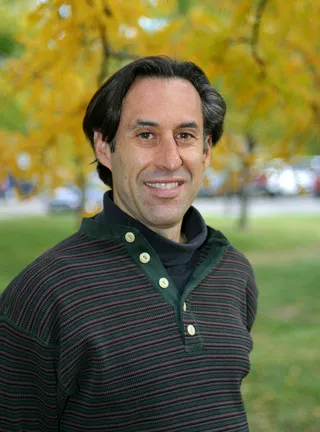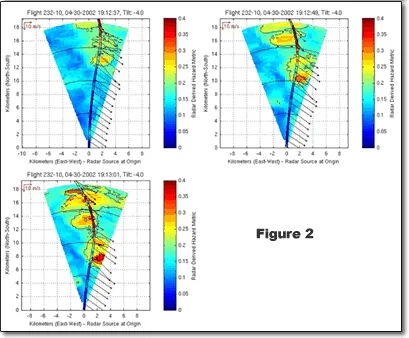Larry Cornman - Physicist
Smoothing the way for air travel

Carlye Calvin, UCAR
Larry Cornman's career path has been unpredictable, somewhat like the turbulence he loves to study. Even though he enjoyed math and science as a schoolchild, his diverse interests pulled him in unexpected directions, such as living in a Zen Buddhist monastery after graduating high school.
"When everyone else wanted to go to college, I focused on other things," Larry recalls. "I don't think ever in my life did I try to map out a career path. Instead I would follow the path of whatever interested me at the time."
Larry is a physicist in NCAR's Research Applications Laboratory, where he studies the relatively small-scale motions of the atmosphere that could endanger aircraft. For groundbreaking work on a warning system that helps pilots avoid turbulence, Larry and his colleagues have won an award from NASA and inclusion in the 2003 list of 50 outstanding achievements of the year from Scientific American magazine.
Larry also holds eight patents for improvements to such tools as wind profilers that help pinpoint pockets of turbulent air.
"I like understanding the theory and then taking something that's complicated and giving it practical applications," he says. "If I had planned a career, I think turbulence would have been it. It combines physics and mathematics, as well as being a very beautiful and complex subject."
Unlike many colleagues, however, Larry spent several years away from science. After high school in the Los Angeles area, he lived in two Zen monasteries on the California coast and then spent several months reading Russian literature and working near Santa Cruz. After that, he lived for four years on a commune in northern California.
He also began taking classes in community college in a variety of subjects, from pottery to physics. Eventually, he realized how much he loved science and decided to pursue a career in it.

Figure 1 shows three weather radar images, 12 seconds apart, as a pilot would see them in the cockpit. But in this test case, the colors have been modified to enhance the visibility of storms (green and yellow regions). With the standard color scheme typical of cockpit radar, these storms would barely show up, giving the pilot little information about the impending turbulence encounter.
"Seeing" in-cloud turbulence. Larry and colleagues at NCAR have developed an algorithm, or mathematical method, to detect storm turbulence in advance of an encounter. Their technique uses the Doppler radars already installed aboard many commercial aircraft, without modifying the radar itself. These images from flights aboard a NASA B-757 research aircraft in 2001 illustrate the method's potential.
"In retrospect, I'm very glad for the time I took to explore other things," Larry says. "It helped me focus on the right kind of career for me. A lot of young people go straight from high school to college without ever having the time to figure out what they want with their lives."
Larry earned bachelor's degrees in math and physics at the University of California, Santa Cruz. He was pursuing a master's and Ph.D. in physics at the University of Colorado in Boulder when he took a job at NCAR as a part-time computer programmer. After he got his master's, it turned into a full-time job, and he never worried about getting a Ph.D.
"I don't feel that the lack of the Ph.D. has hindered my career at NCAR, though I do think that it's an 'expected' thing for someone in my position," Larry says. "On the other hand, if I had finished the degree, I probably wouldn't have ended up at NCAR."
For his first major NCAR assignment, Larry joined a research team studying microbursts. These are strong winds in a concentrated area that blast down from a rain shower or thunderstorm. Microbursts can pose a deadly hazard to aircraft, particularly during takeoff and landing. In the early 1980s, the Federal Aviation Administration (FAA) asked NCAR to embark on a study with other organizations to better understand this dangerous type of wind shear and then create an airport system that could detect microburst threats in time to alert nearby aircraft.
Larry and the team devised a set of mathematical formulas and associated logic, called algorithms, to uncover patterns in measurements of air motion that would indicate wind shear. Over five years, he and his colleagues developed key improvements to the FAA's Low Level Windshear Alert System (LLWAS), which is now in place at over 100 airports throughout the United States as well as several other countries. The system uses remote sensors positioned across an airport to measure wind speed and direction, determining the strength of microbursts and pinpointing their location.
Since the adoption of LLWAS and an FAA radar program that Larry also worked on, the Terminal Doppler Weather Radar program, there has not been a single fatal crash due to microbursts at an equipped airport.

Figure 2 shows the same instances as Figure 1. Using the radar's Doppler channel and the NCAR algorithm, turbulence was detected up to 18 kilometers (11 miles) ahead of the aircraft (yellow and red indicate hazardous levels). In an operational system, detection would trigger display of a warning icon on the radar screen, giving the pilot sufficient time—more than 30 seconds—to take evasive action.
For comparison and verification, the multicolored, wavy vertical line across each image shows the turbulence actually experienced at the same times, measured as vertical acceleration aboard the aircraft. Click here or on the image to enlarge.
Research funded by NASA; Illustrations courtesy Larry Cornman, NCAR
The importance of such research was brought home vividly to Larry one day when he met a pilot who recounted what it was like to receive an alert as his plane headed toward a microburst. "The guy looked at me," Larry recalls, "and said, ‘If it wasn't for your work I'd be dead and 89 other people on the plane would be dead.'"
After working on the wind shear programs, Larry turned to turbulence. He was approached by the International Civil Aviation Organization to review proposed mathematical formulas to measure and report turbulence from airplanes in flight. At the time, the only data on turbulence—the sudden, invisible gusts that buffet a plane and its passengers in midair—came from pilot reports of bouncy or choppy air.
Concerned that the methods were inadequate, he and his colleagues worked on developing a new approach. Larry created an algorithm that relies on measurements of how much the aircraft bounces up and down (taken from the plane's vertical accelerometer) while accounting for its weight, air speed, altitude, and whether the plane is on autopilot or not.
"We were solving an inverse problem," Larry explains. "If I measure what the aircraft's doing, I can infer what the turbulence must have been."
The algorithm is now the international standard for in-flight reporting of both clear-air and in-cloud turbulence. Currently, 200 aircraft from United Airlines have deployed NCAR software based on this mathematical approach, and aircraft from Southwest and Delta Airlines will soon be reporting in-flight turbulence based on a newer version that measures turbulence more directly.
While working on this project, Larry saw the potential to get more information about turbulence from the radar systems that are mounted on commercial airplanes. Those systems were designed to map out thunderstorms and detect wind shear.
Larry's work led to a software system called the NCAR Efficient Spectral Processing Algorithm (NESPA), which helps pilots navigate storms without encountering air turbulence. In 2003, scientists tested NESPA on a NASA B-757 aircraft as it flew through numerous thunderstorms. "We caught over 80% of the turbulence encounters, with very few false detections," Larry says. "It's always satisfying to see theoretical efforts come alive in the real world."
Larry finds such work immensely satisfying. "To me it is a matter of creativity," he says. "You also have to realize that not all of your ideas will be good ones, but you have to keep trying so that eventually you will find that one idea that does work."
by David Hosansky
June 2006
Updated: September 2011